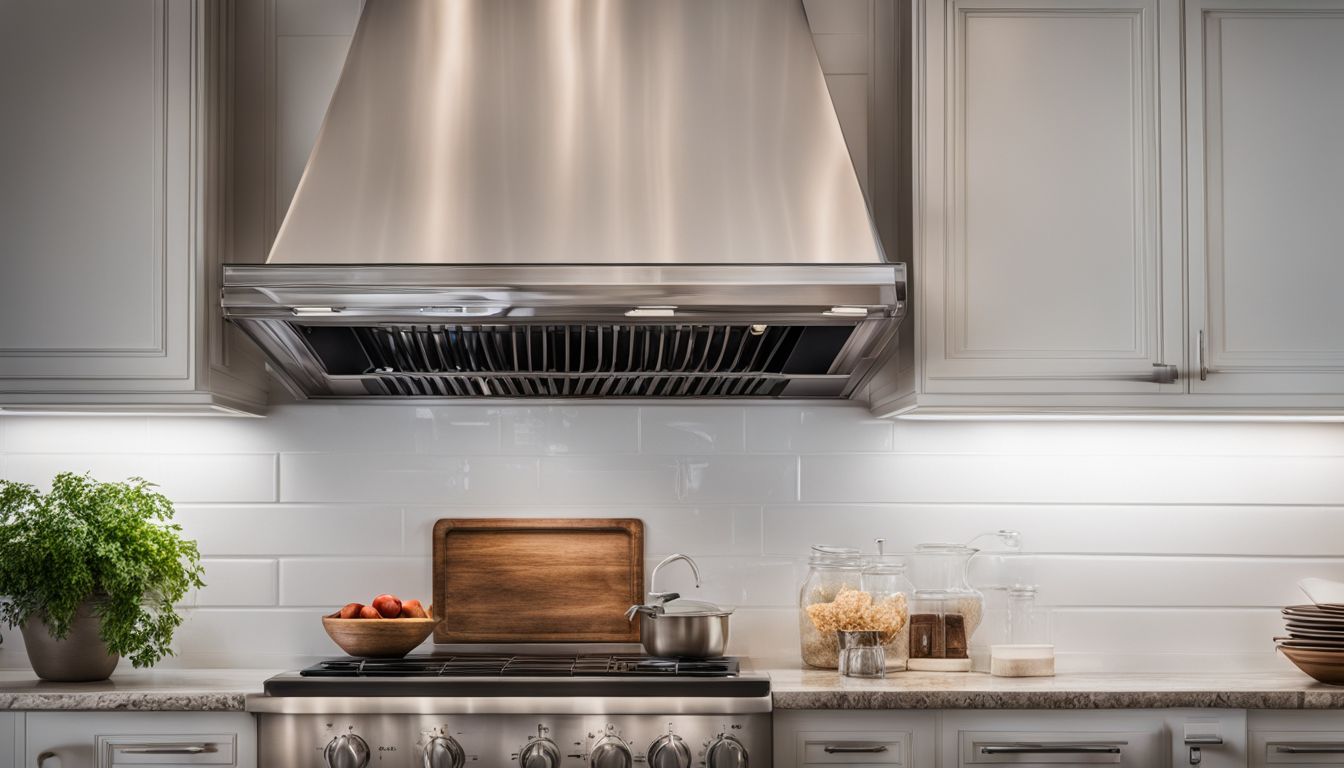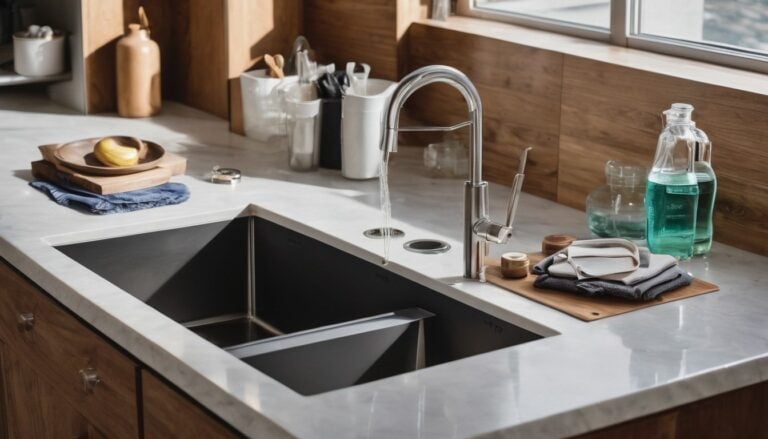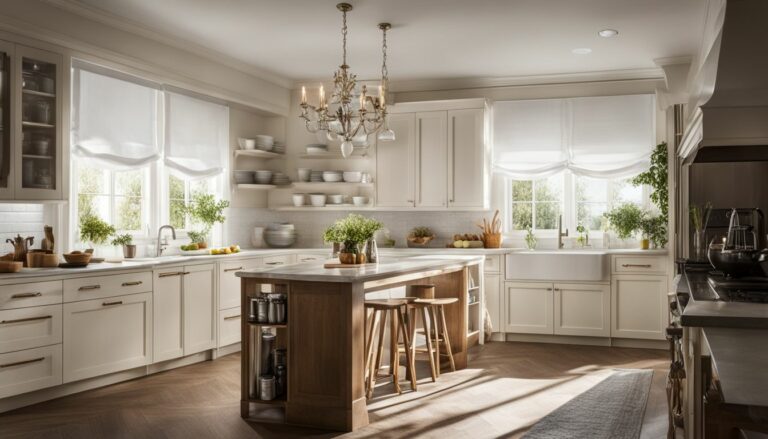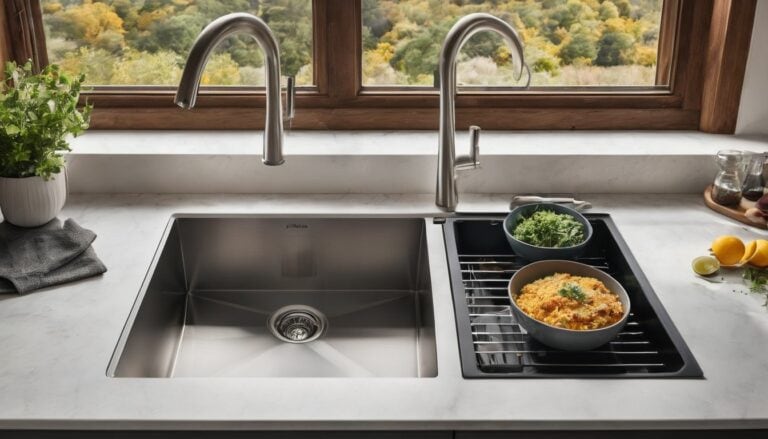Can I Connect Kitchen Vent to Dryer Vent – Explore Pros And Cons
Have you ever pondered, ‘Can I connect kitchen vent to dryer vent?’ You’re in good company! The short answer is no, The idea of simplifying home ventilation by merging these systems has also sparked my interest.
In fact, I’ve done quite a deep dive into the topic – unearthing a fascinating blend of responses and insights about ventilation systems and their individual specifications. This blog post aims to demystify whether such a connection is feasible, safe or even legal according to building codes – all bundled with enlightening tidbits like how merging two exhausts can significantly ramp up fire risk levels.
Ready for some sizzling info on these humble vents? Let’s jump right in!
Key Takeaways
- It is not recommended to connect your kitchen vent to your dryer vent due to safety concerns and the risk of fire.
- Dryer vents should be made of rigid metal, like aluminum or galvanized steel, while kitchen vents can be made of various materials such as stainless steel or galvanized metal.
- Using a dryer vent for a range hood exhaust can lead to potential issues like grease buildup, clogging, limited airflow, and safety hazards.
- It’s important to follow building codes that prohibit mixing grease and lint in vents and have specific requirements for ventilation systems in certain buildings.
Can I Connect Kitchen Vent to Dryer Vent: Understanding Dryer Vents and Kitchen Vents

Dryer vents are typically made of aluminum or flexible plastic, while kitchen vents can be made of various materials such as stainless steel or galvanized metal.
Material used for dryer vents
Dryer vents are made of special materials. We should not use plastic or vinyl for these vents. They can melt from the heat and start a fire! The best choice is rigid metal, like aluminum or galvanized steel.
This material stands up to heat well and keeps its shape longer. If we need to hide the vent inside a wall, we must use metal ducts. For joints in the duct, the end where air flows out must point in that same direction.
This rule stops lint from getting stuck at joint edges! Using right materials will keep everyone safe when using dryers at home.
Types of kitchen vents
Many homes have kitchen vents. There are many kinds of kitchen vents to pick from! One type is exhaust vents. These help pull out bad air from the room. You will often see them near stoves.
Another type is hood filters. They work to catch and keep hold of grease in the air that comes off your food when you cook it. Then there’s ventilation fans, they help push fresh air into your kitchen space.
Range hoods are also popular choices for kitchens too! This kind helps get rid of extra heat and smoke while you’re cooking up a meal on the stove top.
Can You Use a Dryer Vent for a Range Hood Exhaust?

Using a dryer vent for a range hood exhaust can be both possible and practical, but it also presents some potential issues and safety concerns.
Pros and cons of using a dryer vent for a range hood
Using a dryer vent for a range hood has its own set of pros and cons. Here’s a brief overview:
| Pros | Cons |
|---|---|
| Convenience: It’s handy if your kitchen is close to your laundry room, making setup easier. | Can lead to clogging: Using a dryer vent for range hood exhaust could potentially result in lint buildup, thus clogging the ducts, as outlined in [IMPORTANT FACTS]. |
| Can be an Effective Solution: Some people find it an effective solution for their ventilation needs, as specified in [IMPORTANT FACTS]. | Grease accumulation: Combining a dryer vent with a range hood vent could result in a thin film of grease on the hood vents, which is a potential fire hazard. |
| Cost-Effective: Combining two vents into one duct could lower initial setup costs. | Safety concerns: There are safety issues associated with using a dryer vent for a range hood as it must be kept up to code and meet safety regulations, which could result in additional costs. |
Please evaluate these factors carefully before deciding to use a dryer vent for your range hood exhaust. It’s crucial to make a choice that ensures safety and efficiency in your home.
Benefits of using a dryer vent for a range hood
Using a dryer vent for a range hood can have several benefits. Firstly, it provides an efficient and effective way to exhaust smoke, grease, and odors from your kitchen. This helps to keep your indoor air clean and fresh while cooking.
Secondly, connecting the range hood to a dryer vent eliminates the need for a separate duct system, saving you time and money on installation. Additionally, by utilizing the existing ventilation in your home, it ensures that the range hood operates at its optimal performance level.
Lastly, connecting a kitchen vent to dryer vent allows for proper airflow and prevents any potential issues with limited ventilation or clogging. Overall, this solution is convenient and practical for many homeowners seeking improved kitchen ventilation.
Potential Issues with Using a Dryer Vent for a Range Hood
Using a dryer vent for a range hood can lead to potential issues such as grease buildup and clogging, limited airflow, and safety concerns.
Grease buildup and clogging
Grease buildup and clogging can be common problems if you try to connect your kitchen vent to your dryer vent. When grease accumulates in the vent, it can block the airflow and impair ventilation.
This can lead to a range of issues like hindered airflow, damper malfunction, reduced efficiency, and even potential fire hazards. Additionally, heavy grease buildup may prevent the damper in the range hood vent from opening and closing properly.
It’s important to regularly clean and maintain both your dryer vent and kitchen vent to prevent these problems from occurring.
Limited airflow
Using a dryer vent for a range hood can cause limited airflow. This means that the air won’t be able to circulate properly, which can affect the effectiveness of your range hood in removing smoke, odors, and grease from your kitchen.
Limited airflow can also lead to poor ventilation and potentially harmful air quality in your home. It is important to ensure proper ventilation by using dedicated exhaust ducts for range hoods or considering other venting options that are specifically designed for kitchen use.
Safety concerns
Safety is a top priority when it comes to connecting a kitchen vent to a dryer vent. There are potential issues and hazards that you need to consider. One concern is the risk of fire.
Lint trapped in the dryer vent can ignite if the dryer overheats, so keeping the vent clean and free from clogs is essential for safety. It’s also important to use a smooth metal duct for the dryer vent as this material is less likely to catch fire.
Another consideration is ventilation safety. Canopy hoods should not be used for processes with hazardous potential, as they may not provide adequate protection or ventilation control.
Building Codes for Using a Dryer Vent for a Range Hood
Building codes often prohibit the mixing of grease and lint in vents, and there may be specific requirements for buildings of certain sizes.
Restrictions on mixing grease and lint in vents
I want to highlight an important building code when it comes to using a dryer vent for a range hood. This code prohibits the mixing of grease and lint in vents. It’s essential to keep these substances separate because combining them can lead to clogging and potential fire hazards.
Building regulations prioritize safety, so it’s crucial to follow these guidelines when installing ventilation systems for your kitchen and laundry areas. Proper maintenance, including regular cleaning, is necessary to ensure uninterrupted airflow and prevent any obstructions from harming your home.
Requirements for buildings of certain sizes
In some cases, building codes have specific requirements for buildings of certain sizes when it comes to ventilation systems. These regulations aim to ensure proper airflow and safety within the building.
For example, the NYS Mechanical Code 2020 states that dryer exhaust systems should be independent from all other systems. This means that they should not be connected to kitchen vents or any other type of exhaust system.
Additionally, the IRC Chapter 15 Exhaust Systems provides guidelines for non-commercial one- and two-family dwellings, including restrictions on the proximity of air intake openings to rooftop unit exhausts and kitchen exhausts.
Proper Installation of a Dryer Vent for a Range Hood
When installing a dryer vent for a range hood, it is important to consider where to install it and where not to install it.
Where to install the dryer vent
When installing a dryer vent for your range hood, it’s important to choose the right location. Start by measuring the distance from the floor to the ceiling in the area where you want to install the vent.
If your dryer is against an exterior wall, run the duct straight out from the back of the dryer. This will ensure that airflow is unobstructed and efficient.
Consider whether your dryer vent will be located on an interior or exterior wall, as this can affect installation options. If it’s an underground duct, make sure to carefully plan its placement and consider any necessary permits or regulations.
Remember that there are different venting options available depending on your specific installation scenario. Slim duct dryer vents and other alternatives may be suitable for unique spaces or configurations in your home.
Where not to install the dryer vent
I want to emphasize that there are certain places where you should not install the dryer vent. One crucial thing is to avoid venting the dryer close to a wall or in a location that restricts airflow.
This can lead to performance issues and even potential hazards. Another important point is to not connect the kitchen vent with the dryer vent as this can cause buildup of lint and grease, which can result in ventilation problems.
It’s essential to keep these considerations in mind for proper installation and efficient operation of your dryer vent for a range hood exhaust.
Rules for installing vents high and low
Proper installation of vents for range hoods is crucial to ensure effective ventilation and safety. When installing vents high and low, there are some important rules to follow. It is recommended to use no more than 25 feet of 4-inch duct for dryer vent installation, as this helps maintain proper airflow.
Compliance with the manufacturer’s instructions for dryer exhaust ducts is essential, especially when dealing with commercial clothes dryers. Additionally, there are specific rules of thumb that determine the location for proper ventilation and increase efficiency while reducing the risk of fire.
By following these rules, you can ensure that your range hood functions optimally and keeps your kitchen safe.
Alternatives to Using a Dryer Vent for a Range Hood
There are several alternatives to using a dryer vent for a range hood, such as dedicated exhaust ducts or ventless range hoods. Find out more about these options and which one may be the best fit for your needs.
Dedicated exhaust ducts for range hoods
I highly recommend using dedicated exhaust ducts for range hoods. These separate vents are specifically designed to efficiently remove smoke, steam, and odors from your kitchen when you’re cooking.
By having a dedicated exhaust duct for your range hood, you can prevent any mixing of grease and lint that could occur if it were connected to a dryer vent. This helps to avoid clogs and keeps everything running smoothly.
Having a dedicated exhaust duct for your range hood ensures proper ventilation and eliminates the risk of messy situations caused by mixing different types of exhaust in one vent system.
Ventless range hood options
If you can’t use a dryer vent for your range hood, don’t worry! There are other options available. One option is a ventless range hood. These hoods don’t need an external duct to remove smoke and odors from your kitchen.
They use filters to trap grease and odor particles, then recirculate the clean air back into your home. While they may not be as effective at removing smoke compared to ducted range hoods, they can still help improve indoor air quality by capturing cooking odors and grease.
So if you’re unable to connect your kitchen vent to your dryer vent, consider a ventless range hood as an alternative option for keeping your kitchen well-ventilated.
Considerations Before Using a Dryer Vent for a Range Hood
Before connecting your kitchen vent to your dryer vent, there are a few important factors to consider. From the type of range hood you have to the frequency of cleaning and maintenance, these considerations will help ensure proper ventilation in your home and avoid potential issues down the line.
Keep reading to find out more!
Type of range hood and its exhaust needs
Before considering using a dryer vent for your range hood, it’s important to think about the type of range hood you have and its exhaust needs. Different range hoods have different requirements when it comes to ventilation.
For example, if your range is fueled by gas, you will need an exhausting range hood to safely remove any harmful fumes. In this case, it is recommended to use a dedicated exhaust duct for the range hood instead of connecting it to a dryer vent.
Proper ventilation is crucial for effective removal of cooking odors, smoke, and grease. So, make sure you understand the specific needs of your range hood before making any decisions about using a dryer vent as an alternative option.
Frequency of cleaning and maintenance
Regular cleaning and maintenance of your dryer vent is important to ensure optimal performance and prevent potential problems. It is recommended to have your dryer exhaust vents inspected and cleaned by a professional at least once per year.
This helps remove lint and debris that can build up over time, preventing clogs in the vent system. Additionally, it is advisable to clean your dryer vents at least once every 12 months yourself or with professional help, depending on how often you use the dryer and the types of loads being dried.
By keeping up with regular cleaning, you can maintain efficiency, prevent safety hazards, and extend the lifespan of your dryer.
Ensuring Proper Ventilation for Your Home
Proper ventilation in your home is essential for maintaining a healthy and comfortable living environment. Discover the benefits of separating your dryer and kitchen vents, and how it can lead to better airflow and prevent issues like lint buildup and grease clogs.
Find out more about the importance of proper ventilation in kitchens and laundry rooms by reading on.
Importance of proper ventilation in kitchens and laundry rooms
Proper ventilation in kitchens and laundry rooms is really important. It helps to keep the air circulating and removes any bad smells or fumes that come from cooking or doing laundry.
Having good ventilation also prevents moisture buildup, which can lead to mold and mildew growth. By having a well-ventilated kitchen and laundry room, you can improve the overall air quality in your home by getting rid of pollutants and allergens.
So it’s definitely worth making sure that these areas are properly ventilated for a healthier living environment.
Benefits of separating dryer and kitchen vents
Separating the vents for your dryer and kitchen can bring several benefits to your home. One of the main advantages is that it ensures proper ventilation in both areas. By having separate vents, you can prevent any cross-contamination between the grease and lint from the kitchen and laundry room.
This helps to maintain a cleaner environment and reduces the risk of clogs or buildup in either vent. Additionally, separating these vents allows for better airflow, which improves the efficiency of both your dryer and range hood.
Proper ventilation is important for maintaining good air quality in your home and ensuring the safety of you and your family.
Conclusion
In conclusion, it is not recommended to connect your kitchen vent to your dryer vent due to safety concerns. It’s important to have separate ducts for each appliance. Combining the two can create a high fire risk.
So, it is best to keep them separate and ensure proper ventilation for both your kitchen and laundry room.
FAQs
Can I connect my kitchen vent to my dryer vent?
No, it is not recommended to connect your kitchen vent to your dryer vent as they serve different purposes and have different air flow requirements.
What are the potential risks of connecting a kitchen vent to a dryer vent?
Connecting a kitchen vent to a dryer vent can cause ventilation issues, such as improper airflow and increased risk of fire or clogs in the vents.
Is there any alternative solution if I cannot connect my kitchen vent to my dryer vent?
Yes, there are alternative solutions available such as installing separate ventilation systems for your kitchen and dryer or using an independent exhaust system for each appliance.
Why do kitchen vents and dryer vents need separate systems?
Kitchen vents remove odors, steam, and grease from cooking while the dryer vents expel hot air with moisture from clothes drying. These different types of pollutants require specific airflow conditions that should not be mixed.
Should I consult a professional before making any changes to my ventilation system?
Yes, it’s advisable to consult a professional HVAC technician or contractor who specializes in ventilation systems before making any modifications or connections between different types of vents. They can provide expert guidance based on your specific situation.







